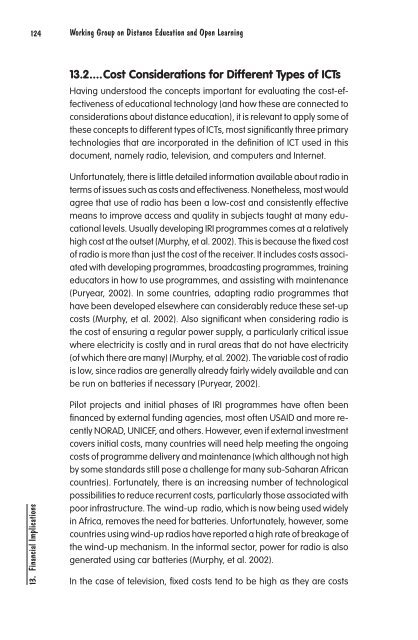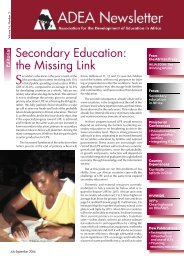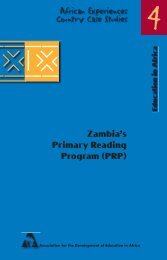Technological Infrastructure and Use of ICT in Education in ... - ADEA
Technological Infrastructure and Use of ICT in Education in ... - ADEA
Technological Infrastructure and Use of ICT in Education in ... - ADEA
Create successful ePaper yourself
Turn your PDF publications into a flip-book with our unique Google optimized e-Paper software.
124 Work<strong>in</strong>g Group on Distance <strong>Education</strong> <strong>and</strong> Open Learn<strong>in</strong>g<br />
13.2....Cost Considerations for Different Types <strong>of</strong> <strong>ICT</strong>s<br />
Hav<strong>in</strong>g understood the concepts important for evaluat<strong>in</strong>g the cost-effectiveness<br />
<strong>of</strong> educational technology (<strong>and</strong> how these are connected to<br />
considerations about distance education), it is relevant to apply some <strong>of</strong><br />
these concepts to different types <strong>of</strong> <strong>ICT</strong>s, most significantly three primary<br />
technologies that are <strong>in</strong>corporated <strong>in</strong> the def<strong>in</strong>ition <strong>of</strong> <strong>ICT</strong> used <strong>in</strong> this<br />
document, namely radio, television, <strong>and</strong> computers <strong>and</strong> Internet.<br />
Unfortunately, there is little detailed <strong>in</strong>formation available about radio <strong>in</strong><br />
terms <strong>of</strong> issues such as costs <strong>and</strong> effectiveness. Nonetheless, most would<br />
agree that use <strong>of</strong> radio has been a low-cost <strong>and</strong> consistently effective<br />
means to improve access <strong>and</strong> quality <strong>in</strong> subjects taught at many educational<br />
levels. Usually develop<strong>in</strong>g IRI programmes comes at a relatively<br />
high cost at the outset (Murphy, et al. 2002). This is because the fixed cost<br />
<strong>of</strong> radio is more than just the cost <strong>of</strong> the receiver. It <strong>in</strong>cludes costs associated<br />
with develop<strong>in</strong>g programmes, broadcast<strong>in</strong>g programmes, tra<strong>in</strong><strong>in</strong>g<br />
educators <strong>in</strong> how to use programmes, <strong>and</strong> assist<strong>in</strong>g with ma<strong>in</strong>tenance<br />
(Puryear, 2002). In some countries, adapt<strong>in</strong>g radio programmes that<br />
have been developed elsewhere can considerably reduce these set-up<br />
costs (Murphy, et al. 2002). Also significant when consider<strong>in</strong>g radio is<br />
the cost <strong>of</strong> ensur<strong>in</strong>g a regular power supply, a particularly critical issue<br />
where electricity is costly <strong>and</strong> <strong>in</strong> rural areas that do not have electricity<br />
(<strong>of</strong> which there are many) (Murphy, et al. 2002). The variable cost <strong>of</strong> radio<br />
is low, s<strong>in</strong>ce radios are generally already fairly widely available <strong>and</strong> can<br />
be run on batteries if necessary (Puryear, 2002).<br />
13. F<strong>in</strong>ancial Implications<br />
Pilot projects <strong>and</strong> <strong>in</strong>itial phases <strong>of</strong> IRI programmes have <strong>of</strong>ten been<br />
f<strong>in</strong>anced by external fund<strong>in</strong>g agencies, most <strong>of</strong>ten USAID <strong>and</strong> more recently<br />
NORAD, UNICEF, <strong>and</strong> others. However, even if external <strong>in</strong>vestment<br />
covers <strong>in</strong>itial costs, many countries will need help meet<strong>in</strong>g the ongo<strong>in</strong>g<br />
costs <strong>of</strong> programme delivery <strong>and</strong> ma<strong>in</strong>tenance (which although not high<br />
by some st<strong>and</strong>ards still pose a challenge for many sub-Saharan African<br />
countries). Fortunately, there is an <strong>in</strong>creas<strong>in</strong>g number <strong>of</strong> technological<br />
possibilities to reduce recurrent costs, particularly those associated with<br />
poor <strong>in</strong>frastructure. The w<strong>in</strong>d-up radio, which is now be<strong>in</strong>g used widely<br />
<strong>in</strong> Africa, removes the need for batteries. Unfortunately, however, some<br />
countries us<strong>in</strong>g w<strong>in</strong>d-up radios have reported a high rate <strong>of</strong> breakage <strong>of</strong><br />
the w<strong>in</strong>d-up mechanism. In the <strong>in</strong>formal sector, power for radio is also<br />
generated us<strong>in</strong>g car batteries (Murphy, et al. 2002).<br />
In the case <strong>of</strong> television, fixed costs tend to be high as they are costs

















